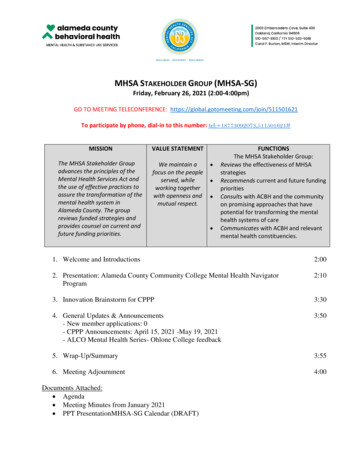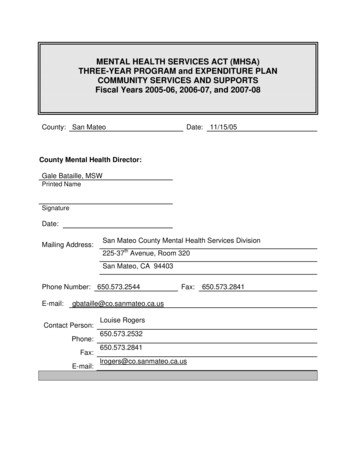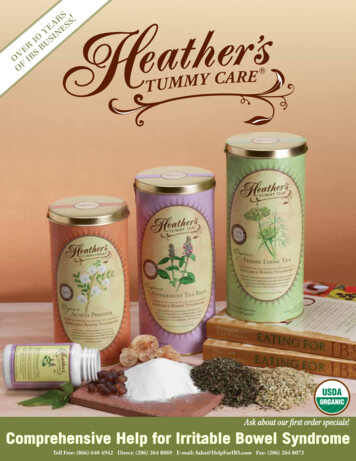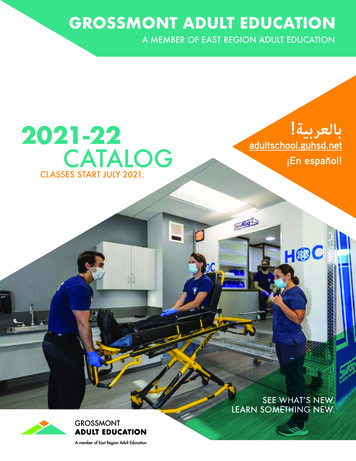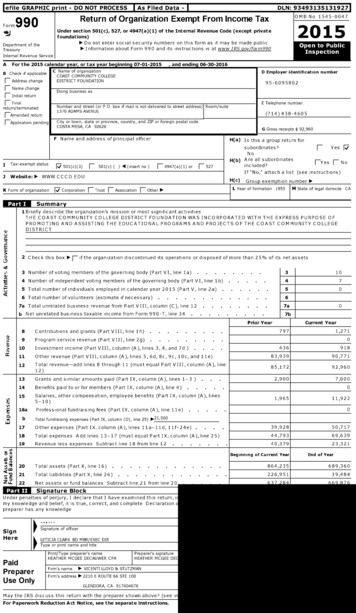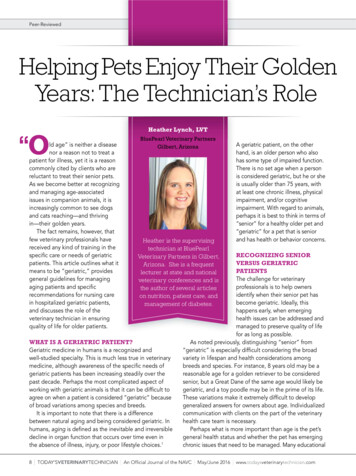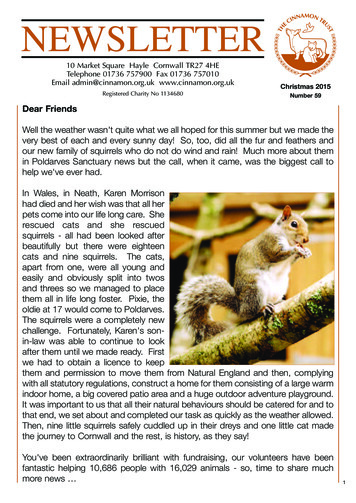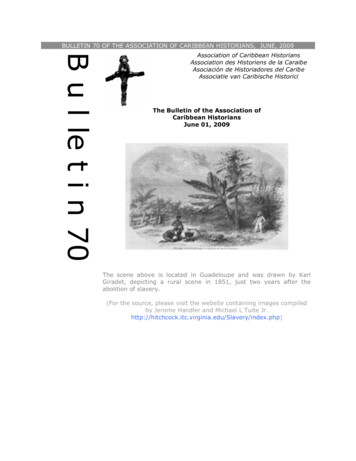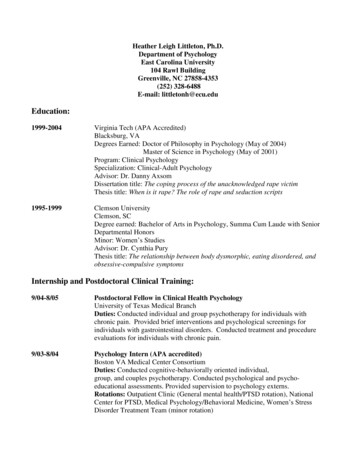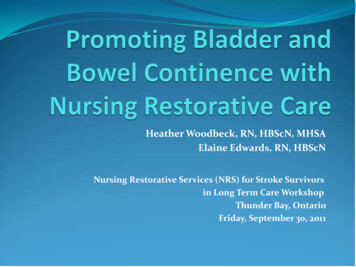
Transcription
Heather Woodbeck, RN, HBScN, MHSAElaine Edwards, RN, HBScNNursing Restorative Services (NRS) for Stroke Survivorsin Long Term Care WorkshopThunder Bay, OntarioFriday, September 30, 2011
AcknowledgementsThis presentation was adapted from previousones done for improving Continence CareCollaborative (IC3) & IC5 Projects.As well as.Central South Regional StrokeProgram. 2007. Continence and Stroke.
Goal & ObjectivesGoal: Share strategies for managing bladder and bowelproblems in stroke survivors.Objectives: Describe normal bladder function, urinary incontinenceand the effects of stroke on bladder continence Describe normal bowel function, bowel incontinence andthe effects of stroke on bowel continence Discuss assessment and management of bladder and bowelincontinence Connect Nursing Restorative Services and Incontinence. Apply learning to a case study
Normal Bladder Anatomy
Normal bladder function Most adult bladders hold 500–600 ml of urine. When the bladder is about half full, the urge tourinate starts. Urination urge can be suppressed for 1 or 2 hoursuntil the bladder is full, in a person with normalbladder function. Most people urinate 3 to 6 times inthe day and possibly 1-2 timesduring the night.Adapted from Heart & Stroke Tips and Tools forEveryday Living 20105
Incontinence: ‘A condition where involuntary loss of urineor stool is a social or hygienic problem.’(International Continence Society ICS, 1987) Affects over half of Long Term CareResidents (RNAO Prompted Voiding Best Practice Guideline,2011) Isthe most common cause of admission toLong Term Care (Canadian Continence Foundation, 2007)
Incontinence Myths & Truths Incontinence is a normal part of the agingprocess. Little can be done for incontinent residents. Toileting residents every 2 hours canprevent incontinence. Restricting fluids can reduce incontinence. Prompted voiding is an effective method touse with incontinent patients.
Types of Urinary Incontinence Physical : Stress: cough Urge: need to goNow Overflow: leaks out Functional: Need help Transient Short term problem
Stress Incontinence Loss of urine with a sudden increase inintra-abdominal pressure (e.g. coughing,sneezing, exercise) Most common in women Can also happen to menafter prostate surgery.
Urge Incontinence(Overactive Bladder) Loss of urine with a strongunstoppable urge to urinate Usually associated withfrequent urination duringthe day and night Common in women & men Sometimes called anoveractive bladder
Overflow Incontinence Bladder is full at all times andleaks at any time, day or night Usual symptoms are a slowstream and difficulty urinating More common in men as aresult of prostate problems
Functional Incontinence Associated with decreased cognitivecapabilities or physical abilities(e.g. Alzheimer’s Disease, Stroke) Resident is unable to go to thetoilet in time without help.
Transient IncontinenceA short term DIAPPERS (mnemonic)decline in Delirium, depressioncontinence Infectionusually with Atrophic Vaginitissudden or Pharmaceuticalsrecent onset Psychological, pain, polyuriacaused by: Excess fluid, environmentalbarriers Restricted mobility Stool impaction or constipation
Stroke can cause a lossof bowel and engine/module ui intro-en.html
Urinary incontinence is common after stroke 40-60% of stroke survivors are incontinentafter having their stroke.Over time bladder continence canimprove. Upon discharge from hospital: 25% of stroke survivors are incontinent 1 year later: 15% of stroke survivors are incontinentThomas LH, Barrett J, Cross S, French B, Leathley M, Sutton C, Watkins C. Treatment of urinaryincontinence after stroke in adults (Review). Cochrane Database of Systematic Reviews 2009, Issue 1.
Stroke and risk factors forurinary incontinence The more severe the stroke, the greater the likelihoodof urinary incontinence Older age Female sex Speech difficulties Motor weakness Visual field defects Cognitive impairment(Barrett 2001)
Urinary Incontinence and stroke Loss of the ability to identify and respond tothe need to urinate. Loss of bladder control occurs to manystroke survivors right after a stroke butresolves within 8 weeks. The incontinence may come and go or bepermanent. Continuing incontinence is assoc with pooroutcome in both stroke survivor & care giverAdapted from Heart & Stroke Tips and Tools for Everyday Living 2010(Thomas LH, Barrett J, Cross S, French B, Leathley M, Sutton C, Watkins C. Treatment of urinary incontinenceafter stroke in adults (Review). Cochrane Database of Systematic Reviews 2009, Issue 1)17
Stroke and incontinence Damage to frontal lobe associated with urinarydysfunction after stroke Size of lesion, rather than its location, is more likely topredict urinary incontinence Unclear if incontinence is a direct (site of lesion) orindirect (eg functional impairment preventing access)consequence of stroke More of an effect on the lives of stroke survivors whencompared to other groups of people with incontinence (Thomas LH, Barrett J, Cross S, French B, Leathley M, Sutton C, Watkins C. Treatment of urinary incontinence after stroke in adults(Review). Cochrane Database of Systematic Reviews 2009, Issue 1)
Stroke and Urge Incontinence Stroke may cause involuntary bladdercontractions. This causes the stroke survivor to feel a strong urgeto urinate and lose control before reaching a toilet.Adapted from Heart & Stroke Tips and Tools for Everyday Living 201019
Stroke and urinary retention Stroke may interrupt nerve pathways that controlbladder emptying. The survivor does not feel an urge to urinate. The bladder fills, but the person is unable toempty it. Then urine backs up. This can increase the risk of urinary tract infectionand damage the kidneys.Adapted from Heart & Stroke Tips and Tools for Everyday Living 201020
Stroke & Functional IncontinenceContinence can be impaired by a stroke: Vision problems: The survivor may be unable to findthe bathroom/urinal or use the toilet independently. Decreased mobility: The survivor may be unable toget to the bathroom independently or quickly enough. Lack of motor coordination: The survivor may havedifficulty managing clothing, adult diapers, transfers,or the toilet.Adapted from Heart & Stroke Tips and Tools for Everyday Living 201021
Stroke & Functional Incontinence cont’ Communication difficulty-aphasia affectsability to communicate need to void Neglect-visual or body inattention-unaware ofone side of body. Risk of injury/fall. Impulsiveness- affects ability to wait forassistance. Risk of injury/fallAdapted from Heart & Stroke Tips and Tools for Everyday Living 2010
Key Points(adapted from Heart and Stroke Tips and Tools for Everyday Living 2010) Almost half of stroke survivors who have problems withincontinence had the same problems before the stroke It is important to identify all the factors that affect thestroke survivor’s bladder control With lifestyle changes and your support, about 80% ofincontinence problems can be resolved Incontinence is a strong predictor of stroke functionaloutcome(Meijer 2003)
NormalBowelAnatomyAdapted from Heart &Stroke Tips and Toolsfor Everyday Living201024
Normal Bowel FunctionA healthy bowel depends on: How the muscles and nerves work together Eating a high-fibre diet Drinking 6 to 8 cups of non-caffeinated fluidseach dayUsually, bowel movements occur anywhere from 3times a day to 3 times a week.Adapted from Heart & Stroke Tips and Tools for Everyday Living 201025
Constipation - DefinitionTwo or more symptoms in the past 12 months of: Straining* Hardened stools* Feeling of incomplete stool evacuation* Feeling of blockage or obstruction* Need for manual stool evacuation* Less than 3 bowel movements per week* A person has these problems for more than onequarter of their bowel movements.Adapted from Heart & Stroke Tips and Tools for Everyday Living 201026
Constipation Pushing too hard and too oftenwhen having a bowel movementcan weaken pelvic floor muscles Stool “impaction” (hard, “stuck”feces in the rectum) adds tourinary incontinence “Smearing” or “staining” of stool, may be causedby constipation or possible rectrocele.
How stroke can affect bowel function Communication deficit Immobility Poor oral intake Change in diet-texture and intake Lack of appetite Feeding difficulties Mood changeAdapted from Heart & Stroke Tips and Tools for Everyday Living 2010
Incontinence Management Plan Assess the incontinence problem Develop a care plan Implement an individualized toiletingplan that addresses contributingfactors Evaluate effectiveness of interventions Revise as needed
Continence Assessment- Key Elements Incontinence History Fluid Intake Onset Bowels Duration Medical History Daytime / Nighttime Medications Accidents Functional Stress Loss Urge Loss Aware of LossAbility
Incontinence - Assessment Medical Problems like Cognitive Impairment,Stroke, etc. Past Medical or Surgical History ie Childbirth Aging - Loss of pelvic muscle tone &atrophic changes Urinary Tract Infections Overweight
Incontinence – Assessment High Caffeine Intake High Alcohol Intake Poor Fluid Intake Medications Constipation Decreased Mobility Environmental Factors
Assessement- Cognitive CapacityRequirements for Continence aware of urge to void able to get to the bathroom able to suppress the urge until resident reachesthe bathroom able to void when resident gets to the BR
Stroke & Bowel ProblemsConstipation: Stroke can weaken the muscles that expel the stooland cause constipation. This also happens whenthe bowels don’t move often enoughDiarrhea: Diarrhea is marked by frequent, watery stools. Causes can range from viral infections (flu) toserious medical problems (ex Crohn’s disease) Fecal incontinence is often mistaken for diarrheaAdapted from Heart & Stroke Tips and Tools for Everyday Living 2010
RAI MDS SECTION H:CONTINENCE IN LAST 14 DAYSH1a BOWEL CONTINENCEControl of bowel movement, withappliance or bowel continenceprograms, if usedH1b BLADDER CONTINENCEControl of urinary bladder function (ifdribbles, volume insufficient to soakthrough underpants), withappliances (e.g. foley) or continenceprograms,if usedH2 BOWELELIMINATIONPATTERN (Check all thatapply in LAST 14 DAYS.)a. Bowel elimination patternregular—at least 1movement every 3 daysb. Constipationc. Diarrhead. Fecal impactione. NONE OF ABOVEResident Assessment Instrument (RAI) RAI-MDS 2.0 User’s Manual.Canadian Version. 2010
RAI MDS SECTION H: DEFERCONTINENCE IN LAST 14 DAYS (Cont.)H3 APPLIANCES ANDPROGRAMS(Check all that apply in LAST 14 DAYS.)a. Any scheduled toileting planb. Bladder retraining programc. External (condom) catheterd. Indwelling cathetere. Intermittent catheterf. Did not use toilet, commode, urinalg. Pads or briefs usedh. Enemas, irrigationi. Ostomy presentj. NONE OF ABOVEH4 CHANGE INURINARYCONTINENCEResident’s urinary continencehas changed as compared tostatus of 90 DAYS AGO (orsince last assessment if lessthan 90 days).0. No change 1. Improved 2.DeterioratedResident Assessment Instrument(RAI) RAI-MDS 2.0 User’sManual. Canadian Version. 2010
Individualized Assessment ToolRAI-MDSComplementaryAssessment An assessment for usewith residents whotrigger the ContinenceResident AssessmentProtocol (RAP) orwhere a more detailedcontinence history ontinence#Assessment-Tools
AssessmentToolMonthlyBowel Record: This recorddescribes bowelmovements,laxative use es/continence#Assessment-Tools38
Continence & Restorative Care In Ontario, Continence Retraining is notcaptured or documented NursingRestorative Care (P3). A Resident on- Any scheduled toileting plan(H3a) or a Bladder Retraining Program(H3b), may contribute to the RUG's score.
Continence Program Criteria Resident must have been assessed by RN to ensurethat they have restorative potentialAND Resident has difficulty locating the toilet OR Resident has difficulty in transferring and/orwalking to the toilet OR Resident may have symptoms of incontinence, ie.Stress, urge, frequency, etc.Active Health Management. 2010. RAI-MDS and Nursing RestorativeServices Training Manual
Toileting Programs Resident’s care plan must show that the resident’stoileting program was: organized, planned, Documented, monitored and evaluated. Toileting programs are for residents whosecontinence can be improved or maintained by theirtoileting plan.Minnesota Dept. of Health. 2004. Nursing Rehabilitation/Restorative Care and MN Case Mix
Incontinence ManagementStrategies The Best Incontinence Intervention for yourresident depends on: the resident’s history and the type of incontinence, etc.Thomas LH, Barrett J, Cross S, French B, Leathley M, Sutton C, Watkins C.Prevention and treatment of urinary incontinence after stroke in adults. CochraneDatabase of Systematic Reviews 2005, Issue 3.
Scheduled Toileting Plan (H3a)using Prompted Voiding Assess resident’s bowel/bladder pattern witha voiding record to determine the mostappropriate times to toilet the resident. Set a measureable, resident-centered goal: Resident will be 100% bladder continentduring days and evenings.
Scheduled Toileting Plan (H3a)using Prompted Voiding Clearly describe toileting plan so all staff cantoilet the resident. Document the resident’s incontinence daily. Monitor the effects of toileting program andmake adjustments to the plan as necessary. Reevaluate the resident at least quarterly.
Assessment ToolVoiding Record: A 3-day, hourly fluidintake and urine outputrecord. Useful for determiningwhen a resident voids inrelation to intake for aprompted urces/continence#Assessment-Tools45
Prompted Voiding Approach Resident when he/she would normallyvoid. Monitor - Ask the resident if he/she needs to use thetoilet. Prompt - Remind the resident to use the toilet and try notto void between prompted voiding sessions. Praise - Give positive feedback to resident to reinforcedryness and appropriate toileting Carefully record and monitor resident’s responseRNAO. 2011. Promoting Continence Using Prompted Voiding
Bladder RetrainingBladder retraining gradually increases the timebetween going to the bathroom. This helps thesurvivor to: Correct the habit of frequent voiding Increase bladder capacity Suppress the feeling of urgency The plan may include pelvic floor exercises whichinvolve tightening and relaxing the muscles of thepelvic floorAdapted from Heart & Stroke Tips and Tools for Everyday Living 201047
Bladder RetrainingThe protocol also includes a schedule for urinatingsuch as this: Periodically increase the interval between voids by15 minutes (or less if needed) Continue increasing the intervals until the timebetween voids is 3 to 4 hoursWhat you can do to help: Remind and encourage the survivor to practicepelvic floor exercises, as neededAdapted from Heart & Stroke Tips and Tools for Everyday Living 201048
Incontinence Strategies Encourage the stroke survivor to sit leaningforward during urination, with the feet flat on thefloor or on a stool If the stroke survivor uses a urinal, keep it where itcan be easily seen and reached - try placing oneurinal on each side of the bed. Bedpan: Make sure the head of the bed is raised asupright as possible to allow the survivor to sit asnormally as possible when using a bedpan.Adapted from Heart & Stroke Tips and Tools for Everyday Living 201049
Constipation Strategies Gravity andincreased abdominalpressure promotemore completebladder and bowelemptying than usinga bedpan.Adapted from Heart & StrokeTips and Tools for EverydayLiving 201050
More Incontinence Strategies Encourage independence and self-care: Suggest Adaptable clothing Communicate – Work out ways so yourresident can tell you what he or she needs Use Adaptive devices – commode, grabbars, urinals, bed pans, call bells Give PrivacyAdapted from Central South Regional Stroke Program. 2007. Continenceand Stroke.
Other Incontinence Strategies Use Dementia Care strategies,Responsive Behaviour strategies, PIECES Use Environmental prompts. ie. signs Delay incontinent product use untilafter everything else has been tried.Adapted from Central South Regional Stroke Program. 2007. Continence andStroke.
Hygiene & Incontinence StrategiesGive good hygiene & skin care: Wipe from front to back after voiding Change underwear daily or more often if soiled Always provide thorough peri-care afterurinary or fecal incontinence. Wear gloves for peri-care, remove the gloves, washyour hands, and wash the hands of the strokesurvivorAdapted from Heart & Stroke Tips and Tools for Everyday Living 201053
Hygiene & Incontinence Strategies Do not use deodorant sprays, powder, or perfumeson perineal skinContinence products Use the right sized continence products. Do notdouble up liners and products or use over-sizedproducts. Watch for leaking, tightness, skin irritation, or rash. Report redness, irritation, or skin breakdown toregistered staff.Adapted from Heart & Stroke Tips and Tools for Everyday Living 201054
Key Incontinence Strategies Do an individualized resident assessment andset goals. (Thomas LH, Barrett J, Cross S, French B, Leathley M, Sutton C,Watkins C. Prevention and treatment of urinary incontinence after stroke in adults.Cochrane Database of Systematic Reviews 2005, Issue 3.) Use a type of Scheduled toileting, likepromoted voiding.(Ostaszkiewicz J, Johnston L, Roe B. Timedvoiding for the management of urinary incontinence in adults. Cochrane Database ofSystematic Reviews 2004, Issue 1.) Ensure Adequate fluid intake – 1500ml/day(MOHLTC standard)Adapted from Central South Regional Stroke Program. 2007. Continenceand Stroke.
Case Study – Mabel Mabel is a 77 year old woman, recently widowed, withno family support locally.
She was admitted to your long term care home 1 monthago. She had a left hemisphere stroke 3 months ago. Prior to her stroke she was living independently in herown home with some support from CCAC.
Mabel has mild expressiveaphasia (difficulty getting herwords out). She also has weakness in herright arm, hand and leg Mabel is able to walk shortdistances with a walker butmainly uses a wheelchairthroughout the day. She isable to transfer to a chair withhelp from one person. She requires assistance witheating and dressing.
She has occasional urinaryincontinence. In the past week Mabel hasstarted to cry for noapparent reason. She appears to be havingmemory difficulties. Mabel has occasionaloutbursts of shouting atstaff and other residents.
Activity
Resources RNAO Promoting Continence Using Prompted Voiding: A PDA Guide.http://www.rnao.org/pda/void - Condensed version of the Continence BPG.Excellent summary in English and French. RNAO BPG – Promoting Continence Using Prompted Voiding.http://www.rnao.org/Page.asp?PageID 1212&SiteNodeID 155&BL ExpandID BestPractice Guideline. Anna and Harry Borun Center for Gerontological Research. IncontinenceManagement Training un/modules/Incontinence management/about.htm . A clearly written, self-learning package that breaks the processinto steps-assessment, responsiveness, maintenance and audits. Includes voidingrecords, monitoring forms, MDS subscales, etc. Highly recommended. Ouslander JG, Schnelle JF, Uman G, Fingold S, Nigam JG, Tuico E, & Bates-JensenB. Predictors of successful prompted voiding among incontinent nursing homeresidents. J Am Med Assoc, 1995b; 273(17):1366-1370. Good discussion of factors toconsider if a resident will benefit from prompted voiding.
Resources Folden, SL et al. 2002. Rehabilitation Nursing Foundation (RNF) PracticeGuidelines for the Management of Constipation in Adults. RNF Glenview, Ill.http://www.rehabnurse.org/about/research.html. Hinrichs, M & Huseboe, J. 2001. Management of Constipation. University ofIowa Gerontological Nursing Interventions Research Centre, Iowa City, Iowa. Joanna Briggs Institute for Evidence Based Nursing and Midwifery. 1999.Management of Constipation in Older Adults. Adelaide, ng 3 1.pdf. Registered Nurses Association of Ontario. 2005. Prevention of Constipation inthe Older Adult Population, Nursing Best Practice Guideline. Toronto,Ontario. http://www.rnao.org. Thomas LH, Cross S, Barrett J, French B, Leathley M, Sutton CJ, Watkins C.Treatment of urinary incontinence after stroke in adults (Review) TheCochrane Collaboration. 2009, Issue 1
Change in diet -texture and intake . Indwelling catheter . e. Intermittent catheter . f. Did not use toilet, commode, urinal . g. Pads or briefs used . Stress, urge, frequency, etc. Active Health Management. 2010. RAI-MDS and Nursing Restorative Services Training Manual . Toileting Programs
